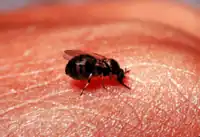蚋
| ||||||||
Translingual
Han character
蚋 (Kangxi radical 142, 虫+4, 10 strokes, cangjie input 中戈人月 (LIOB), four-corner 54127, composition ⿰虫内)
References
- Kangxi Dictionary: page 1077, character 20
- Dai Kanwa Jiten: character 32850
- Dae Jaweon: page 1546, character 17
- Hanyu Da Zidian (first edition): volume 4, page 2838, character 14
- Unihan data for U+868B
Chinese
| trad. | 蚋 | |
|---|---|---|
| simp. # | 蚋 | |
Glyph origin
Phono-semantic compound (形聲/形声) : semantic 虫 + phonetic 內 (OC *nuːbs).
Pronunciation
Compounds
- 蚊蚋
Japanese

Readings
Etymology 1
| Kanji in this term |
|---|
| 蚋 |
| ぶゆ Hyōgaiji |
| kun’yomi |
Usage notes
The standard Japanese name.[2]
As with many terms that name organisms, this term is often spelled in katakana, especially in biological contexts (where katakana is customary), as ブユ.
Etymology 2
| Kanji in this term |
|---|
| 蚋 |
| ぶよ Hyōgaiji |
| kun’yomi |
Noun
- blackfly (fly of the family Simuliidae)
-
- 蚋は人をも馬をも刺します。あの長くて丈夫な馬の尻尾の房々とした毛は、蚋を追ひ拂ふのに役に立つのです。
- Buyo wa hito o mo uma o mo sashimasu. Ano nagakute jōbu na uma no shippo no fusafusa to shita ke wa, buyo o oiharau no ni yaku ni tatsu no desu.
- Blackflies bite both people and horses. The long, strong, and bushy hair on horses’ tails is helpful in driving away blackflies.
- 蚋は人をも馬をも刺します。あの長くて丈夫な馬の尻尾の房々とした毛は、蚋を追ひ拂ふのに役に立つのです。
-
Usage notes
Used in eastern Japan.[2]
As with many terms that name organisms, this term is often spelled in katakana, especially in biological contexts (where katakana is customary), as ブヨ.
Etymology 3
| Kanji in this term |
|---|
| 蚋 |
| ぶと Hyōgaiji |
| kun’yomi |
Usage notes
Used in western Japan.[2]
As with many terms that name organisms, this term is often spelled in katakana, especially in biological contexts (where katakana is customary), as ブト.
References
- Matsumura, Akira, editor (2006), 大辞林 [Daijirin] (in Japanese), Third edition, Tōkyō: Sanseidō, →ISBN
- “ブユ(蚋)”, in 世界大百科事典 第2版 (Sekai Dai-hyakka Jiten Dainihan, “Heibonsha World Encyclopedia Second Edition”) (in Japanese), Tōkyō: Heibonsha, 1998
Korean
Hanja
蚋 • (ye) (hangeul 예, revised ye, McCune–Reischauer ye, Yale yey)
- This term needs a translation to English. Please help out and add a translation, then remove the text
{{rfdef}}.